Hong Kong Art Week illustrates how the idea of art as therapy is steadily gaining ground in the city. At art fairs, galleries, museums and beyond, it’s time to affirm the efficacy of art’s remedial value. Faye Bradley reports.
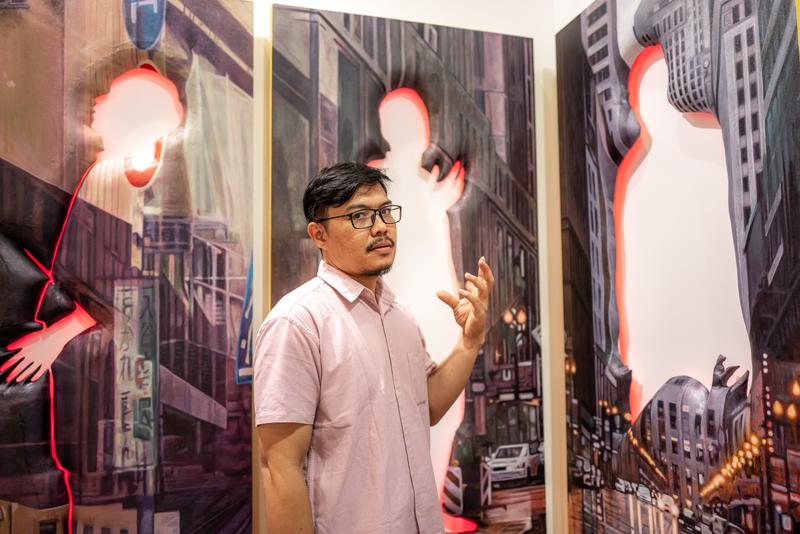 Indonesian artist Taufik Ermas channels the trauma of being trapped under rubble into his paintings. Life-size cutouts of human figures in his works reflect the psychological scars he has sustained. Brought to Art Central by Artemis Art. (ANDY CHONG / CHINA DAILY)
Indonesian artist Taufik Ermas channels the trauma of being trapped under rubble into his paintings. Life-size cutouts of human figures in his works reflect the psychological scars he has sustained. Brought to Art Central by Artemis Art. (ANDY CHONG / CHINA DAILY)
An Art Basel Hong Kong (ABHK) panel will examine the role of art in therapy tomorrow — the closing day of the city’s annual flagship art fair at the Hong Kong Convention and Exhibition Centre (HKCEC). Speakers include Cynthia Tongson, the custodian of the artistic legacy of her late brother, Hong Kong’s Wesley Tongson; as well as artists Yuki Iiyama, Indu Antony and Christine Wong Yap. Melissa Karmen Lee, CEO of the Chinese Canadian Museum in Vancouver, serves as moderator.
The conversation will explore how art can create conditions for healing when it comes to mental health. Lee believes this is possible when “we can access that special connection” artists are capable of making while trying to “understand the human brain, body and environment” through their art. She is hoping to delve into the background and practice of each artist on the panel, and highlight “how this might apply to care and mental healing”.
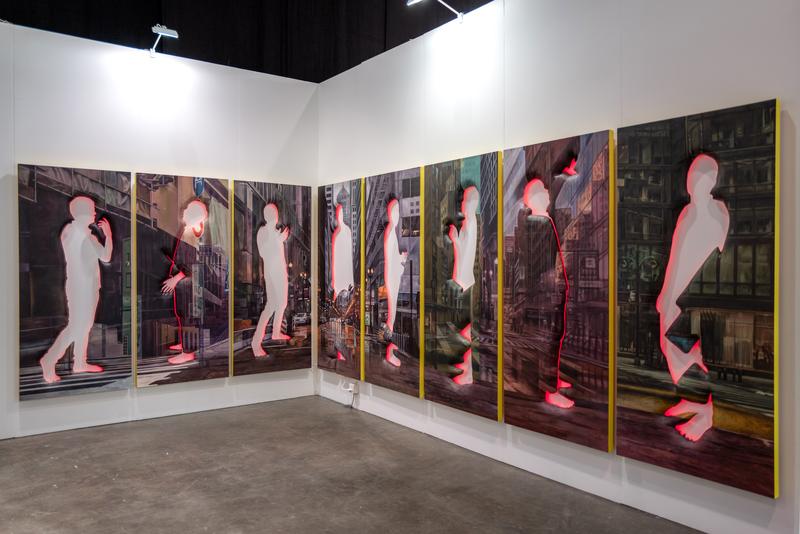 Indonesian artist Taufik Ermas channels the trauma of being trapped under rubble into his paintings. Life-size cutouts of human figures in his works reflect the psychological scars he has sustained. Brought to Art Central by Artemis Art. (ANDY CHONG / CHINA DAILY)
Indonesian artist Taufik Ermas channels the trauma of being trapped under rubble into his paintings. Life-size cutouts of human figures in his works reflect the psychological scars he has sustained. Brought to Art Central by Artemis Art. (ANDY CHONG / CHINA DAILY)
“The goal of the event is to eradicate the taboo around talking about mental health,” says Antony, who was raised in a conventional family in the Indian state of Kerala and hence has reason to appreciate how growing “gender accessibility” has proved a game-changer in the field of mental health.
“Art acts as a medium for people to express themselves and provides a space for people to be themselves,” she adds. “I believe in starting conversations around topics that affect me personally.”
Stephanie Bailey curated ABHK’s Conversations and Salon program. She acknowledges Wellcome Trust’s role in supporting the panel. “Their Mindscapes project partners with artists and institutions across the world to create exhibitions that open up empathetic and generative spaces to reflect on and talk about mental health, while exploring how art can create pathways for open communication, understanding and healing,” she adds.
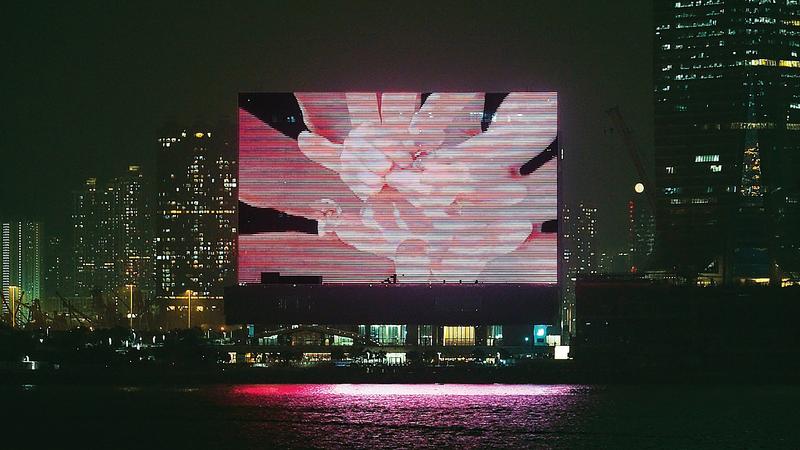 Swiss visual artist Pipilotti Rist’s digital installation, Hand Me Your Trust, adorns M+ museum’s facade. (PHOTO PROVIDED TO CHINA DAILY)
Swiss visual artist Pipilotti Rist’s digital installation, Hand Me Your Trust, adorns M+ museum’s facade. (PHOTO PROVIDED TO CHINA DAILY)
Sustained support
Art Central, which runs concurrently with ABHK and at the same venue, has demonstrated a sustained commitment to promoting art as therapy. The Sovereign Art Foundation (SAF) returns to Art Central with its free Spectrum of Emotion Workshop — offering an interactive experience that encourages children aged 6 to 12 to go on a self-guided tour of selected artworks.
“We’re delighted to have this opportunity to showcase our programming to the Hong Kong public, so they can experience the therapeutic benefits of art firsthand and better understand our charitable mission,” says Tiffany Pinkstone, SAF’s executive director.
Bev Butkow, represented by Johannesburg’s Guns & Rain gallery, is participating in Art Central. The South African artist makes woven sculptures, inviting viewers to touch the works. “The tactility of my work physically engages the body of the viewer, encouraging them to slow down and engage with the world through their senses,” Butkow explains. “My deep hope is that my forms possess regenerative powers, possibly even healing powers.”
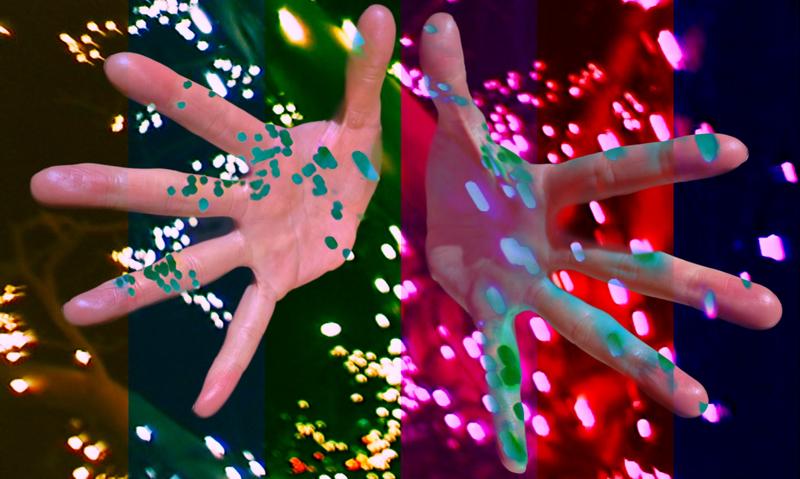 A striking image from Rist’s video. An offsite project of Art Basel Hong Kong, the piece highlights the power of human touch. (PHOTO PROVIDED TO CHINA DAILY)
A striking image from Rist’s video. An offsite project of Art Basel Hong Kong, the piece highlights the power of human touch. (PHOTO PROVIDED TO CHINA DAILY)
Art Central is joining forces with Asia Society Hong Kong Center to host a panel titled The Healing Power of Art. Speakers include Grace Cheng, director of the charitable institution Art in Hospital; William Chow, associate fellow of the Hong Kong Professional Counselling Association; and Laurence Wood, professor of cultural and creative arts at the Education University of Hong Kong.
Meanwhile, one of ABHK’s offsite projects, Swiss artist Pipilotti Rist’s Hand Me Your Trust, is playing on one of the world’s largest media facades, the M+ screen. Through June 17, the meditative, introspective video art piece will explore the power of human touch. “My work looks at hands not only as working and creating, but also ornamentally: our hands can be beautiful extensions of our emotions, to communicate with other living beings without words,” says the artist in a statement.
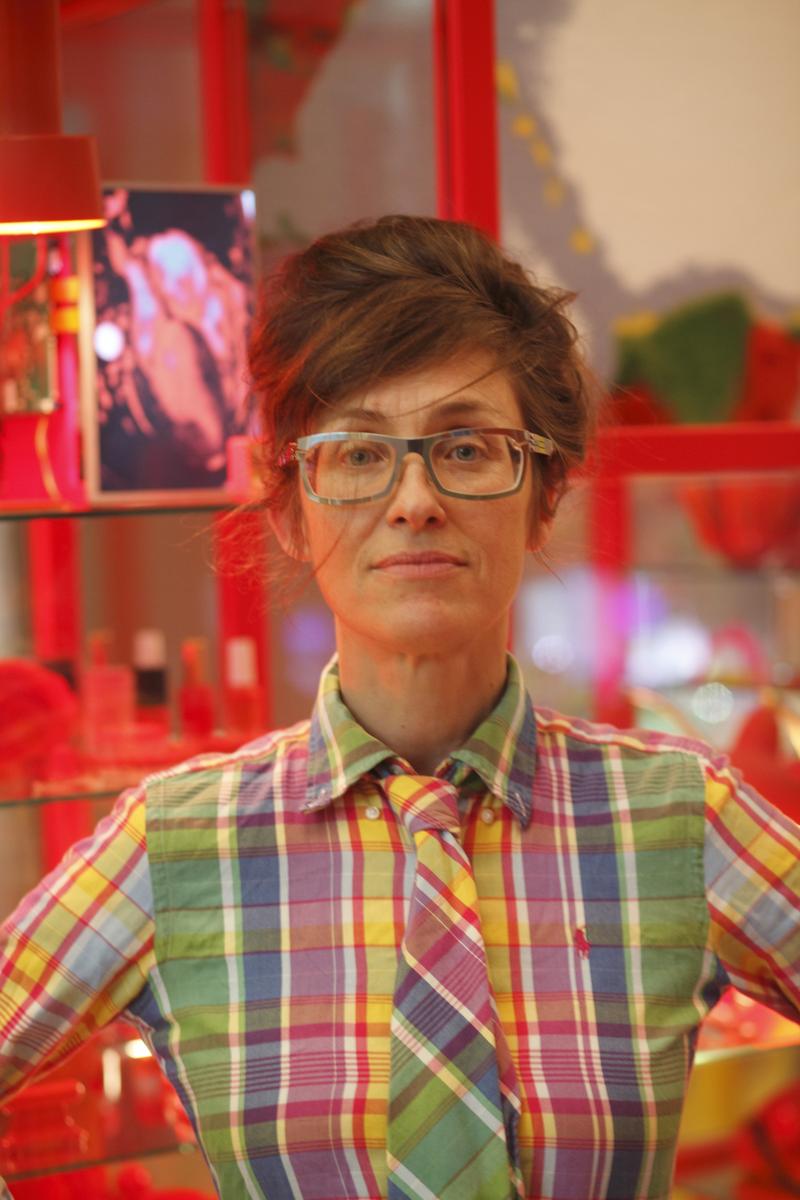 Pipilotti Rist. (PHOTO PROVIDED TO CHINA DAILY)
Pipilotti Rist. (PHOTO PROVIDED TO CHINA DAILY)
Sweet escape
An increasing number of artists are exploring mental health-related themes as part of their practice. Wu Didi’s paintings of malleable bamboo stalks and tangled weeds, brought to Art Central by Contemporary by Angela Li gallery, have a calming effect on the viewer. Tracing the lines visually can be a form of meditation.
Also showing at Art Central are works by Indonesian painter Taufik Ermas (represented by Artemis Art). Ermas was trapped under rubble following the 2006 earthquake that devastated the Javanese city of Yogyakarta. The psychological scars he still bears are manifest in the artist’s specially crafted canvases replete with collage, needlework figures and cutouts.
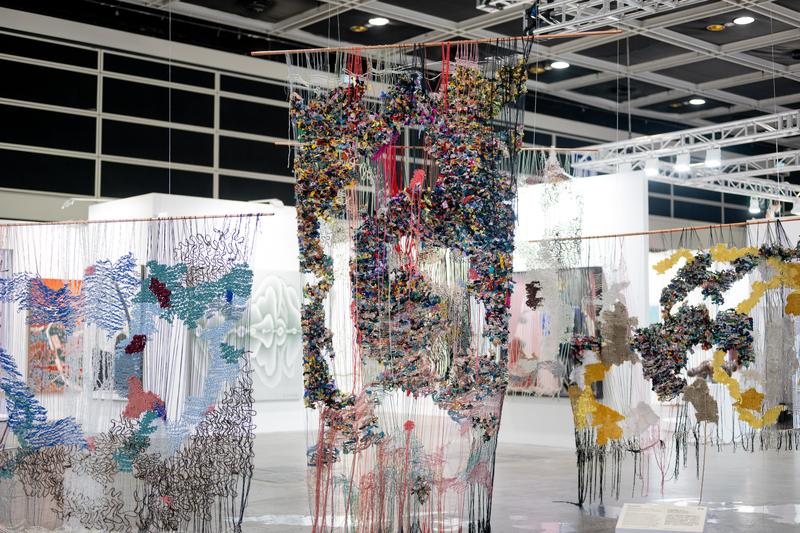 Bev Butkow’s woven sculptures on display at Art Central. GBA briefs
(PHOTO PROVIDED TO CHINA DAILY)
Bev Butkow’s woven sculptures on display at Art Central. GBA briefs
(PHOTO PROVIDED TO CHINA DAILY)
Mental-health-themed art is also represented in Hong Kong’s gallery district. Not too far away from the site of the art fairs at HKCEC, New York-based Stacy Leigh’s solo show, Escape to B-Roll, is on show at WOAW Gallery’s Central space. The 10 paintings exhibited here were triggered by the artist’s fantasy of “selling her apartment and moving to a house somewhere with no neighbors”.
“I think it’s important to shine a light on mental health; I just try to do it with humor,” says Leigh. The show was conceived as an escape from the dispute the artist was having with the management of the New York condo she was living in at the time. “I used the canvases to create a little world I could escape into and forget about the ugly situation I was forced to live with.”
She hopes that viewers will have their own takeaways from her paintings: “I find that once I release a work of art into the world, to be seen by other people, their interpretation exposes something I had not seen before.”
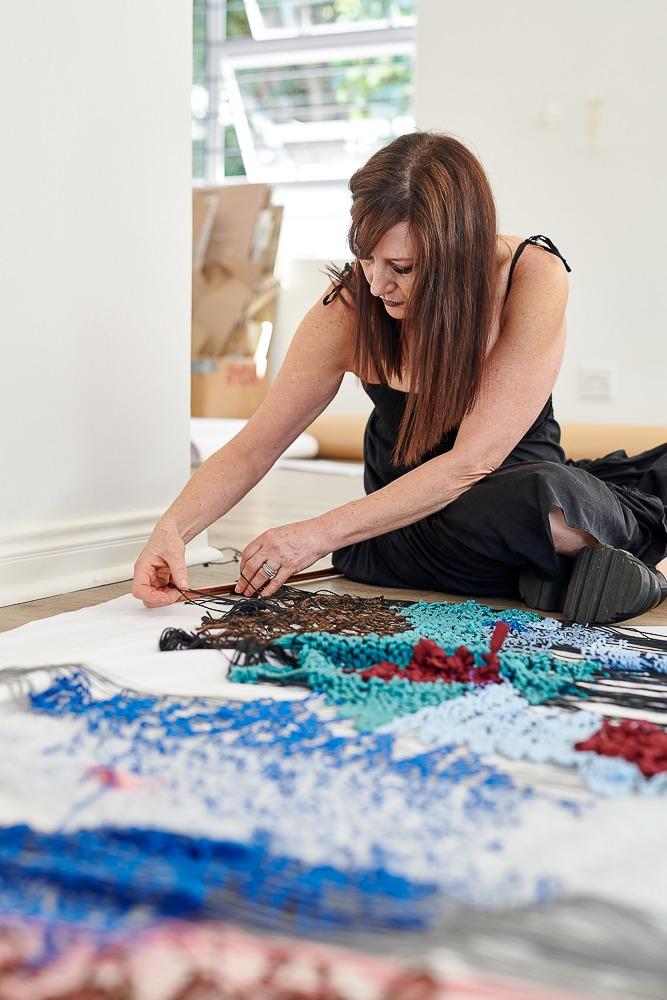 Represented by Guns & Rain gallery of Johannesburg, Butkow invites viewers to touch her works. The idea is to slow down and feel the tactility in one’s surroundings, in order to engage with them better. (PHOTO PROVIDED TO CHINA DAILY)
Represented by Guns & Rain gallery of Johannesburg, Butkow invites viewers to touch her works. The idea is to slow down and feel the tactility in one’s surroundings, in order to engage with them better. (PHOTO PROVIDED TO CHINA DAILY)
Creative insight
Meanwhile, M+ is bringing new meaning to Yayoi Kusama’s striking, colorful oeuvre with its Expressive Arts Therapy Experiential Workshops, held in collaboration with the University of Hong Kong’s (HKU’s) Centre on Behavioral Health (CBH). The immersive sessions invite participants to express themselves through visual art, physical movement and creative writing. Inspiration is drawn from the Japanese artist’s life philosophy and love of polka dots — as seen in the museum’s current retrospective, Yayoi Kusama: 1945 to Now. M+ is also hosting Kusama-themed Family Day Art Workshops, suitable for families with small children.
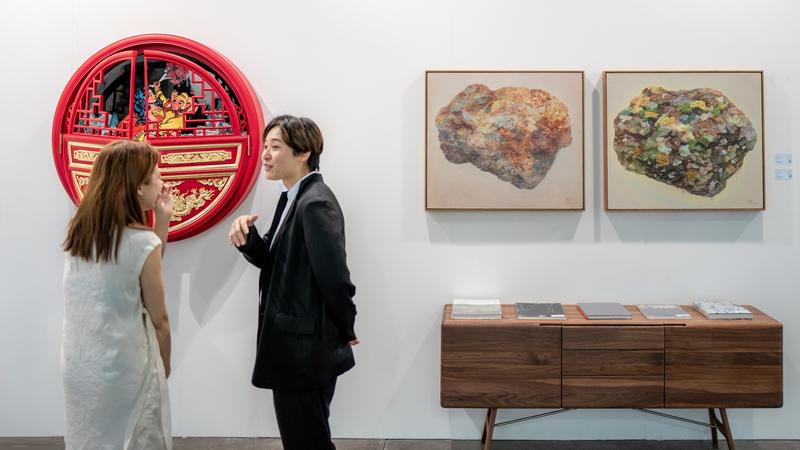 Visitors enjoying the show at Art Central. (ANDY CHONG / CHINA DAILY)
Visitors enjoying the show at Art Central. (ANDY CHONG / CHINA DAILY)
Keri Ryan, M+’s lead curator of learning and interpretation, explains that expressive arts therapy provides the museum’s audience a chance to “explore their feelings and connect to their inner self, apart from viewing the exhibition”. The multimodal discipline combines creative writing, music, drama, visual arts and dance.
“Participants are guided by the therapists to explore their feelings, body and mind using different creative mediums in a safe and welcoming environment,” Ryan explains. “We hope that Kusama’s works and philosophy of life can become a powerful inspiration for participants to experience the healing aspects of art, and realize their own creativity through the art-making process.”
 Gazing at Wu Didi’s paintings, brought to Art Central by Contemporary by Angela Li, can be a meditational experience. (ANDY CHONG / CHINA DAILY)
Gazing at Wu Didi’s paintings, brought to Art Central by Contemporary by Angela Li, can be a meditational experience. (ANDY CHONG / CHINA DAILY)
Art therapy is in growing demand. According to the Hong Kong Expressive Arts Therapy Service Center, from May to July 2022 — while the fifth wave of COVID-19 was raging — the number of people approaching the charity for assistance increased by two to three times.
Stress levels and cases of depression soared along with infection numbers, says Julia Byrne, a local psychotherapist and art therapy pioneer who is also founding president of the Hong Kong Association of Art Therapists.
“In a modern, international city like Hong Kong, mental-health issues are still stigmatized, and topics related to mental illness are always shrouded in taboo, which hinders open communication within society,” says CBH’s director, Rainbow Ho Tin-hung, who is also the program director of HKU’s Master of Expressive Arts Therapy. “We need to (speak up) ... to help destigmatize mental-health problems, so we can face them and take positive action to address them.” Art therapy is an effective mode of treatment and has the added benefit of being nonpharmacological, she notes.
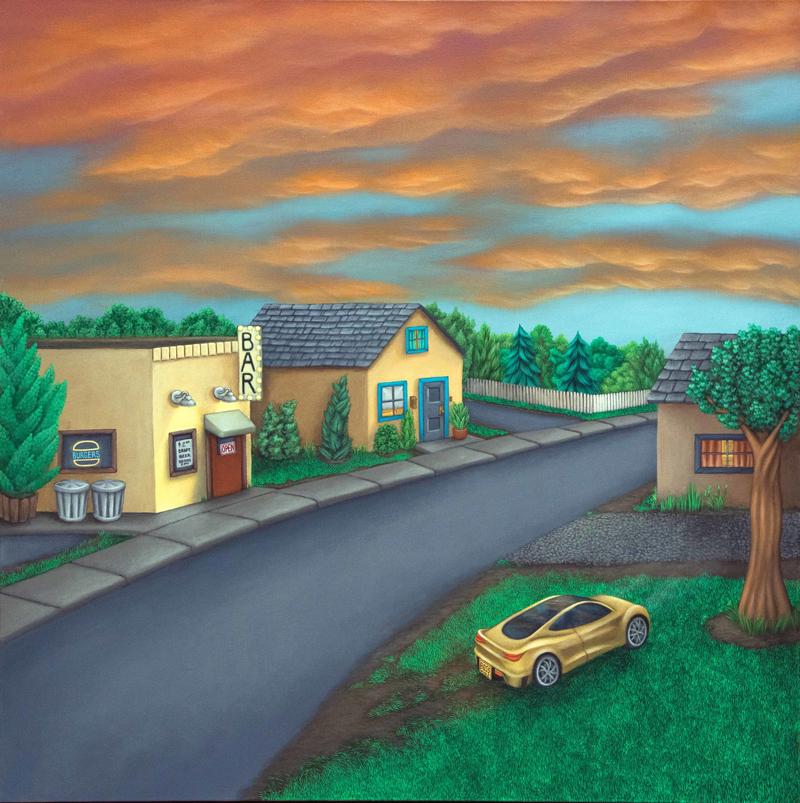 Stacy Leigh processed the stress of having to deal with the management of her New York apartment by painting fantasy landscapes with picture-perfect houses and “no neighbors”. Her works are now on show at WOAW Gallery in Central. (PHOTO PROVIDED TO CHINA DAILY)
Stacy Leigh processed the stress of having to deal with the management of her New York apartment by painting fantasy landscapes with picture-perfect houses and “no neighbors”. Her works are now on show at WOAW Gallery in Central. (PHOTO PROVIDED TO CHINA DAILY)
Art therapy can be especially beneficial for individuals who have special educational needs or find it difficult to communicate verbally, says Mimi Tung, head of program design and lead art therapist at SAF. “Art provides an alternative means of communicating, processing thoughts (as well as helping a person’s) worldview to evolve,” she adds.
At a typical session, the client is asked to create visual images in the presence of a qualified art therapist. “This process contributes to the externalization of thoughts and feelings, which may otherwise remain unexpressed,” says Byrne. The therapist may then ask open-ended questions about the artwork to stimulate dialogue. “The artwork serves as a mirror for the client to see their internal world.”
 Mimi Tung , head of program design and lead art therapist at the Sovereign Art Foundation flanked by colleagues. (PHOTO PROVIDED TO CHINA DAILY)
Mimi Tung , head of program design and lead art therapist at the Sovereign Art Foundation flanked by colleagues. (PHOTO PROVIDED TO CHINA DAILY)
A flourishing field
Hong Kong has seen a plethora of artists, NGOs and corporations getting involved in art therapy and expressive arts therapy in recent years. At Kwai Chung Hospital, expressive arts therapy is being used to build motivation and inspiration in 200 adults recovering from mental illness.
Joanna To has been working with NGOs to design and facilitate expressive arts therapy workshops for young people and the general public. Following stints at Tsz Shan Monastery and the Changing Young Lives Foundation, To established Arts for Change, offering individual and group workshops and therapy sessions that integrate expressive arts therapy with meditation.
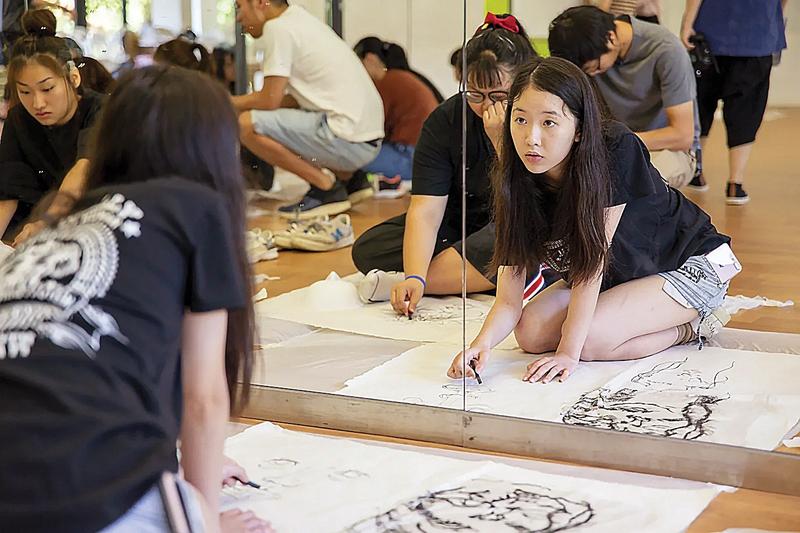 Expressive Arts Therapy Experiential Workshops, hosted by M+ museum with University of Hong Kong’s Centre on Behavioral Health. The immersive sessions invite participants to express themselves through visual art, physical movement and creative writing. (PHOTO PROVIDED TO CHINA DAILY)
Expressive Arts Therapy Experiential Workshops, hosted by M+ museum with University of Hong Kong’s Centre on Behavioral Health. The immersive sessions invite participants to express themselves through visual art, physical movement and creative writing. (PHOTO PROVIDED TO CHINA DAILY)
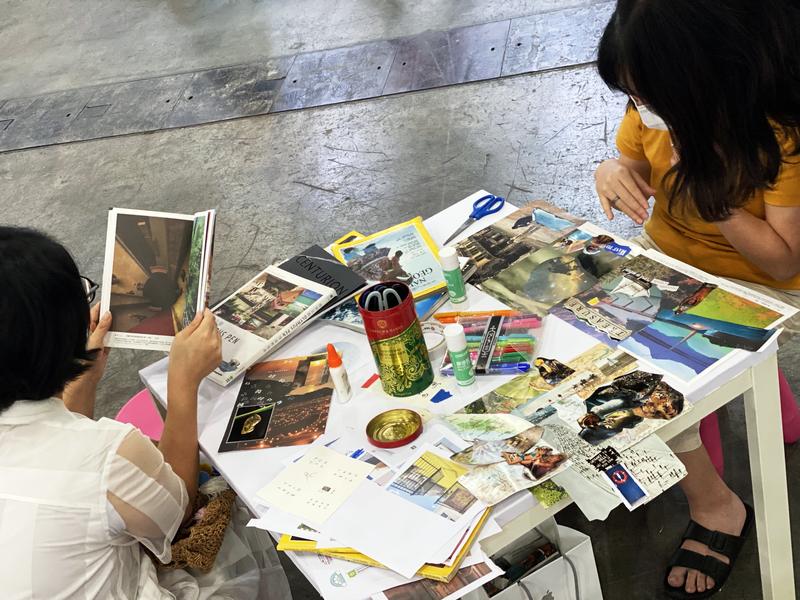 An experiential art therapy session hosted by the Sovereign Art Foundation. (PHOTO PROVIDED TO CHINA DAILY)
An experiential art therapy session hosted by the Sovereign Art Foundation. (PHOTO PROVIDED TO CHINA DAILY)
SAF’s flagship program, Make It Better, provides expressive arts workshops to underprivileged and special education needs children. The charity has helped over 10,000 kids and their family members to date. Recent initiatives by the organization include free community-art fun days in residential districts. “Our next goal is to develop a free online expressive arts resource center for the public,” Pinkstone says.
For the curious, workshops such as those being offered at M+ provide a chance for anyone to get a taste of expressive arts therapy. As Ryan says: “Everyone has the capacity to be creative, and inspired by art and artists.”


